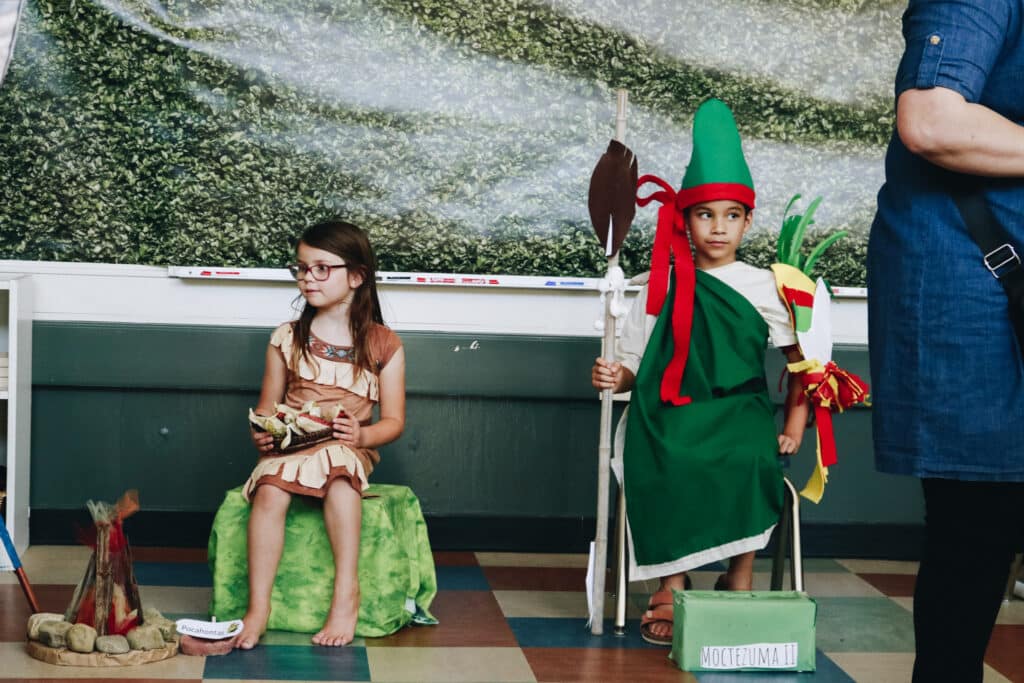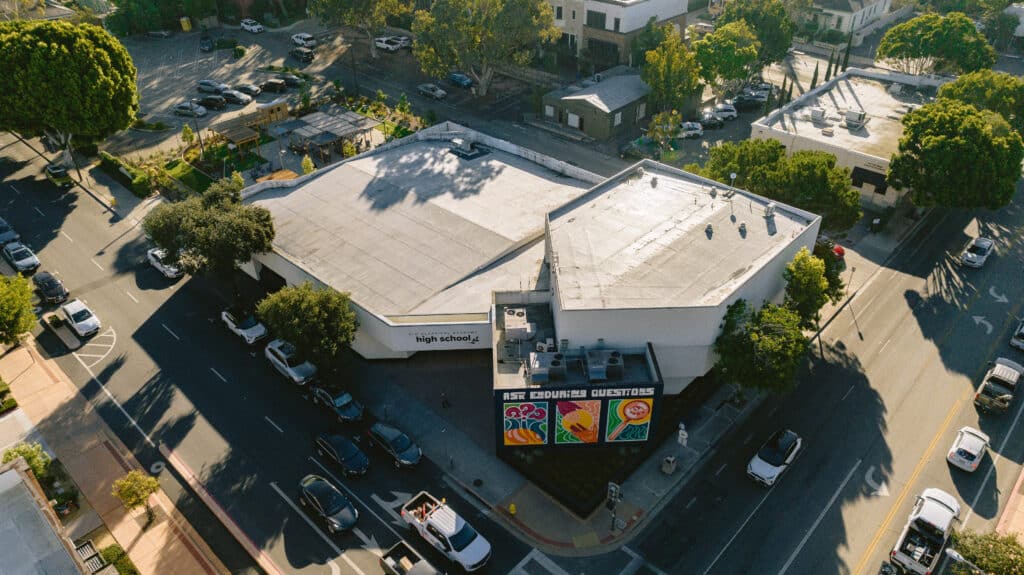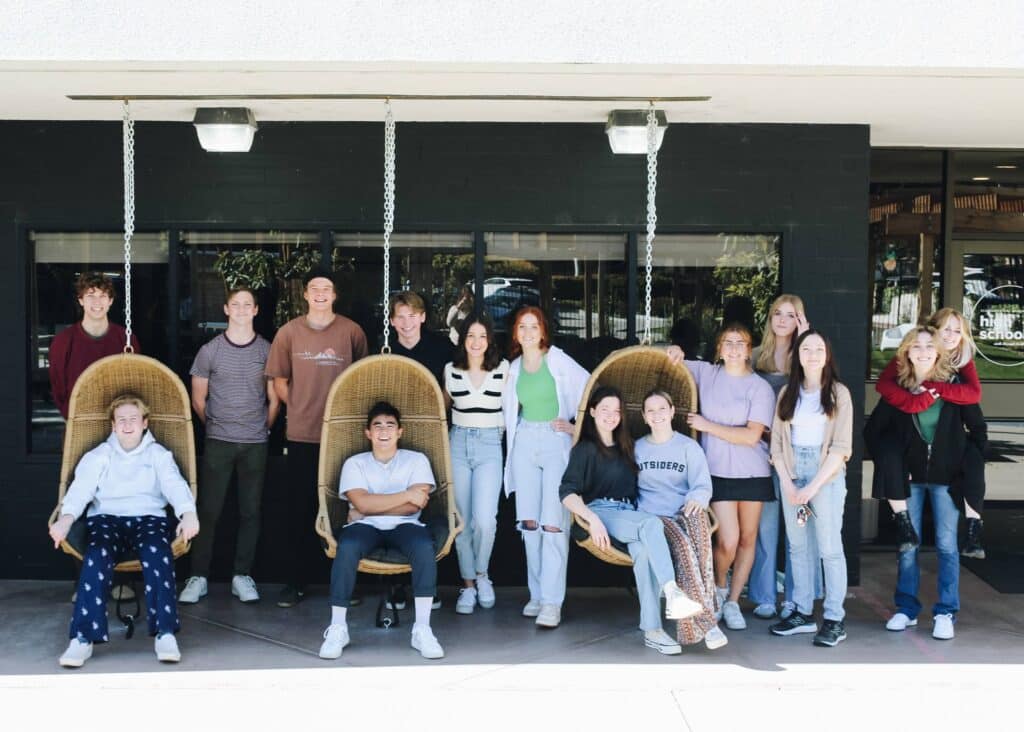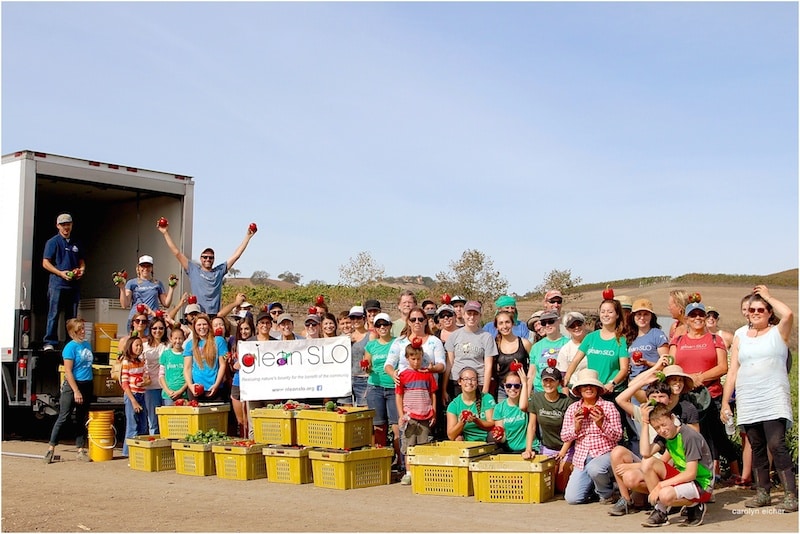
{photos by Carolyn Eicher}
A few of our SLOCA families and teachers had the opportunity recently to harvest peppers with GleanSLO. Many thanks to Carolyn Eicher for organizing this effort, and to the other families who attended and helped. Our high school English teacher Paul McCullough was there that day, and wrote up the following blog post about the wonder of this experience. Thank you Paul, for beautifully capturing this day, and sharing your thoughts:
Civilization begins with writing, and writing begins with food. Humanity’s earliest written records, scratched into baked clay tablets more than 5,000 years ago in ancient Sumer, are nothing more than accounts of who owed how many bushels of wheat to whom. In the beginning, in some of the earliest proto-writing systems, a curious pictographic symbol appears: a man’s head, titled backwards at an angle with a small triangle—presumably a bit of food—floating next to his mouth. Who lived and what happened on this planet in the long millennia before human beings developed writing, archaeology and geology can only speculate by other means. What’s clear is that human civilization and food have been linked in language for—quite literally—as long as history can remember.
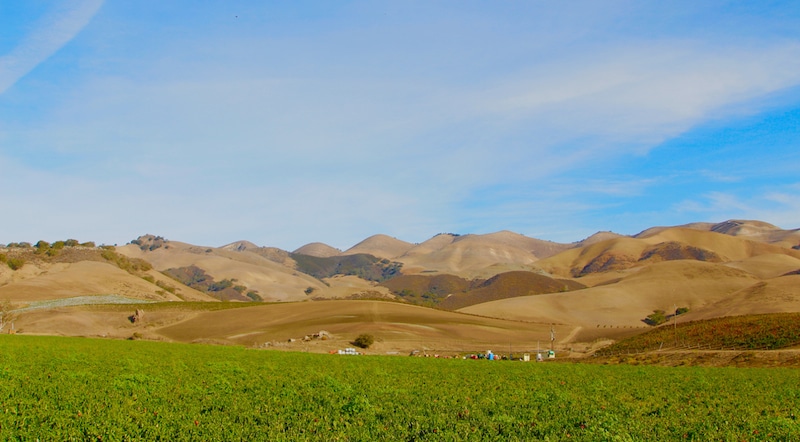 As a consequence, the affinities between culture and agriculture—between the cultivation of the mind and the cultivation of crops—are many and deep. The transitive verb to glean (“to gather slowly, bit by bit”) still applies in both senses: one can glean a field and one can glean knowledge. (“My pen has glean’d my teeming brain,” wrote Keats). To ruminate means “to think on, ponder,” and also “to chew the cud.” “Ours are the only farmers who can read Homer,” bragged Thomas Jefferson (“that most complicated man who stands at the heart of our most complicated civilization,” a professor of mine once mused). Jefferson penned this in a letter to J. Hector St. John de Crèvecoeur, who in his classic Letters from an American Farmer gives us the maxim ubi panis ibi patria. “Where there is bread, there is my country.”
As a consequence, the affinities between culture and agriculture—between the cultivation of the mind and the cultivation of crops—are many and deep. The transitive verb to glean (“to gather slowly, bit by bit”) still applies in both senses: one can glean a field and one can glean knowledge. (“My pen has glean’d my teeming brain,” wrote Keats). To ruminate means “to think on, ponder,” and also “to chew the cud.” “Ours are the only farmers who can read Homer,” bragged Thomas Jefferson (“that most complicated man who stands at the heart of our most complicated civilization,” a professor of mine once mused). Jefferson penned this in a letter to J. Hector St. John de Crèvecoeur, who in his classic Letters from an American Farmer gives us the maxim ubi panis ibi patria. “Where there is bread, there is my country.”
Where there is bread, there is my country. I know this in my bones. To eat together is to belong together. There is no culture, religion, or even casual social event that does not have food at or near the center of it. Imagine the Central Coast without tri-tip, farmers’ markets, and Pinot Noir; consider the centrality of the Eucharist in the Catholic liturgy. And the link between culture and agriculture is not just a romantic belief confined to the past: if human beings one day successfully colonize Mars, as some among us are presently trying to do, becoming in effect an interplanetary civilization, it will be because we have figured out how to grow food up there.
 I confess: I need more dirt roads and green fields in my life—more sunrises, sweat, and odiferous living things. Fewer glowing screens. At the same time, I realize (in a way that perhaps Jefferson did or could not) the place of privilege one must occupy to venture a statement like that, to crave the immediacy and authenticity of manual labor as a palliative for garden-variety suburban ennui. Several summers spent on a cow-calf operation in the southern Sierra Nevada foothills gave me a small but real taste of life as ranch hand, with its many daily hardships and occasional bucolic compensations. It can be a most beautiful life, when freely chosen. But these days I am all hat and no cattle, as they say. Despite my vague agrarian leanings, I am happily employed indoors with my books and my students, both of which are very important to me. These are not things to take for granted. Still, some part of me misses the feeling of dirt beneath my fingernails. I need more work calluses and rope burns, fewer paper cuts.
I confess: I need more dirt roads and green fields in my life—more sunrises, sweat, and odiferous living things. Fewer glowing screens. At the same time, I realize (in a way that perhaps Jefferson did or could not) the place of privilege one must occupy to venture a statement like that, to crave the immediacy and authenticity of manual labor as a palliative for garden-variety suburban ennui. Several summers spent on a cow-calf operation in the southern Sierra Nevada foothills gave me a small but real taste of life as ranch hand, with its many daily hardships and occasional bucolic compensations. It can be a most beautiful life, when freely chosen. But these days I am all hat and no cattle, as they say. Despite my vague agrarian leanings, I am happily employed indoors with my books and my students, both of which are very important to me. These are not things to take for granted. Still, some part of me misses the feeling of dirt beneath my fingernails. I need more work calluses and rope burns, fewer paper cuts.
So last week at the invitation of Carolyn Eicher, a SLOCA parent and co-founder of an organization called Glean SLO, I signed on to glean a field of bell peppers in the hills of Arroyo Grande. This would be the field’s fourth and final picking, and there were still thousands of crisp red and green peppers ripening on the vines that the grocery stores, for a variety of bureaucratic reasons, did not want. Glean SLO’s mission, then, is simple and sensible: “Rescuing nature’s bounty for the benefit of our community.” Last year the organization saved over 200,000 pounds of food from going to waste by organizing volunteer gleaners all over the county to harvest, from large, established farms and neighborhood orange trees alike. It’s no secret that food sometimes grows faster than we can harvest and distribute it. What is less widely acknowledged, and a good deal harder to digest, is that 44,000 of our neighbors on the Central Coast are food insecure, according to Glean SLO’s figures, one third of them children. Why not bring that food to those families?
A second confession: having completed my first harvest with Glean SLO, I will admit that it is perhaps the most agreeable way I can think of to spend a Saturday morning. Driving the back roads over the Edna Valley, I arrived at the pepper field around 9:30 to join about fifty inter-generational gleaners. It was jeans and t-shirt weather. We drank communal coffee outside in the sun, toeing the dirt clods with our shoes and exchanging greetings. College students chattered excitedly with energetic retirees and parents with young children on family outings. About a dozen of us were first timers. Several SLOCA families came out, too, including Wendy Rey, who teaches Little Wonders, and her son Davis. The volunteer coordinators showed us how to select the best peppers and harvest them with a satisfying pluck. Then, filing into the leafy rows, we set about a common purpose.

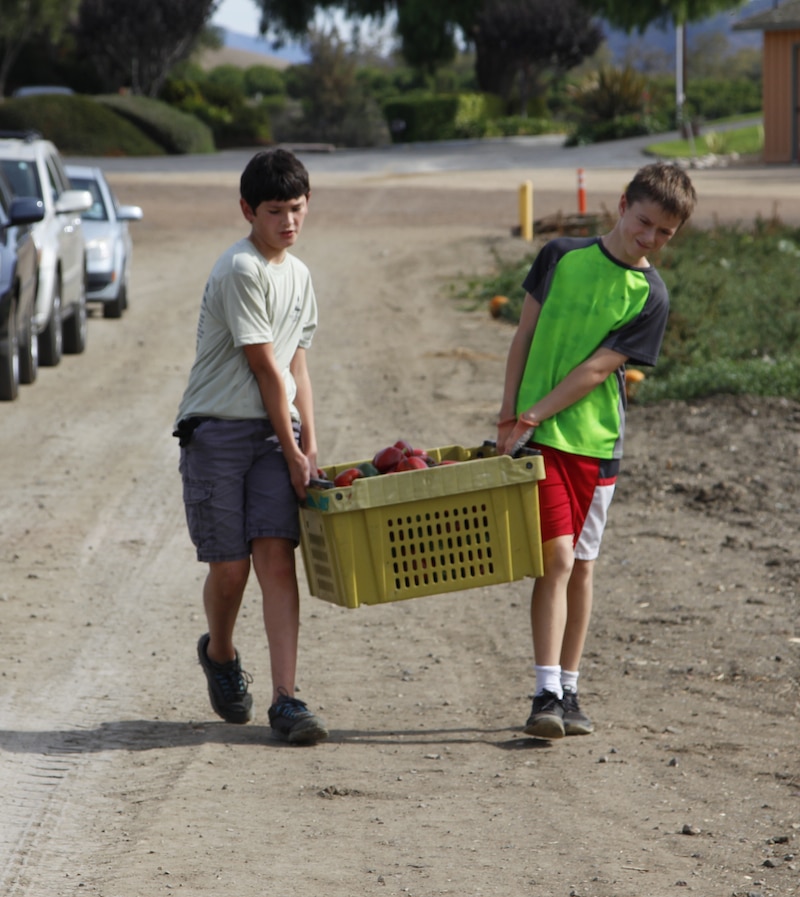 Glean SLO’s second organizing principle is togetherness. Of course, it’s fashionable today to lament the demise of community (by which we too often mean: “people who like all the same things we do”). But here’s what I realized on Saturday: different conversations happen when you’re on your knees in the dirt. It’s not quite the same as exchanging pleasantries with your neighbor in line at the bank. It doesn’t matter where you’re coming from; what matters is that you’re here. Picking peppers. In the dirt. Our common predicament. Like the crumbling wall in Frost’s celebrated poem about the two Yankee farmers, it’s nature’s special province to break down whatever social barriers human beings may raise: “Something there is that does not love a wall, / That wants it down.” (How strange that the most well-known line of this poem, “Good fences make good neighbors,” is so often quoted approvingly, when Frost intends it ironically.) People are hungry—not just for food, but for connection. How much time and money do we as a culture spend trying to feel just a little less alone? Whole industries are predicated upon it. But real connection happens when we rally around the things we all share, “the really human things,” as the Eastern Orthodox theologian and devoted gardener Vigen Guroian puts it, food foremost among them. (What do most people do on a first date? Get coffee. Maybe dinner. If that goes well, Bali’s, or a glass of wine. Food, food, and more food. It’s how we connect.) We need more opportunities for our personal, individual goods (in this case, connection) to align with perennial, communal goods (in this case, healthful food). That is how we unlearn our collective loneliness.
Glean SLO’s second organizing principle is togetherness. Of course, it’s fashionable today to lament the demise of community (by which we too often mean: “people who like all the same things we do”). But here’s what I realized on Saturday: different conversations happen when you’re on your knees in the dirt. It’s not quite the same as exchanging pleasantries with your neighbor in line at the bank. It doesn’t matter where you’re coming from; what matters is that you’re here. Picking peppers. In the dirt. Our common predicament. Like the crumbling wall in Frost’s celebrated poem about the two Yankee farmers, it’s nature’s special province to break down whatever social barriers human beings may raise: “Something there is that does not love a wall, / That wants it down.” (How strange that the most well-known line of this poem, “Good fences make good neighbors,” is so often quoted approvingly, when Frost intends it ironically.) People are hungry—not just for food, but for connection. How much time and money do we as a culture spend trying to feel just a little less alone? Whole industries are predicated upon it. But real connection happens when we rally around the things we all share, “the really human things,” as the Eastern Orthodox theologian and devoted gardener Vigen Guroian puts it, food foremost among them. (What do most people do on a first date? Get coffee. Maybe dinner. If that goes well, Bali’s, or a glass of wine. Food, food, and more food. It’s how we connect.) We need more opportunities for our personal, individual goods (in this case, connection) to align with perennial, communal goods (in this case, healthful food). That is how we unlearn our collective loneliness.
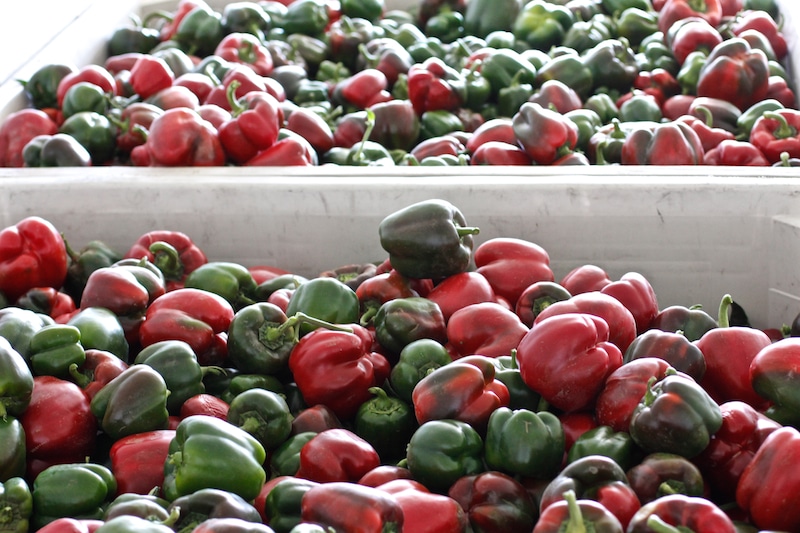 There were more peppers than we could pick. Frost again: “There were ten thousand thousand fruit to touch, / Cherish in hand, lift down, and not let fall.” (What a fascinating list: three positives—“touch,” “cherish,” “lift”—and a negative—“not let fall.”) Fifty of us picked and sputtered and laughed for two-and-a-half hours, harvesting over 5,000 pounds of produce for the food bank. Still, nine-tenths of the field remained ungathered; it will be tilled under to fertilize the soil for next season. I drove away muddy and gladdened, and with a large satchel of peppers to boot. I ate them in stir fry, in salads, with hummus, by themselves. I gave them to my friends and admired their beauty on my shelves for days. Good things only get better when you give them away.
There were more peppers than we could pick. Frost again: “There were ten thousand thousand fruit to touch, / Cherish in hand, lift down, and not let fall.” (What a fascinating list: three positives—“touch,” “cherish,” “lift”—and a negative—“not let fall.”) Fifty of us picked and sputtered and laughed for two-and-a-half hours, harvesting over 5,000 pounds of produce for the food bank. Still, nine-tenths of the field remained ungathered; it will be tilled under to fertilize the soil for next season. I drove away muddy and gladdened, and with a large satchel of peppers to boot. I ate them in stir fry, in salads, with hummus, by themselves. I gave them to my friends and admired their beauty on my shelves for days. Good things only get better when you give them away.
Poems are like that, too. A poem I read to my classes last week, Li-Young Lee’s From Blossoms, contemplates this sense of how food connects us to others, to a context, to a place:
From laden boughs, from hands,
from sweet fellowship in the bins,
comes nectar at the roadside, succulent
peaches we devour, dusty skin and all,
comes the familiar dust of summer, dust we eat.
O, to take what we love inside,
to carry within us an orchard, to eat
not only the skin, but the shade,
not only the sugar, but the days, to hold
the fruit in our hands, adore it, then bite into
the round jubilance of peach.
I confess I am enamored with the quiet ecstasy found in these lines. Who before had ever realized that jubilance is round? But of course, it must be.
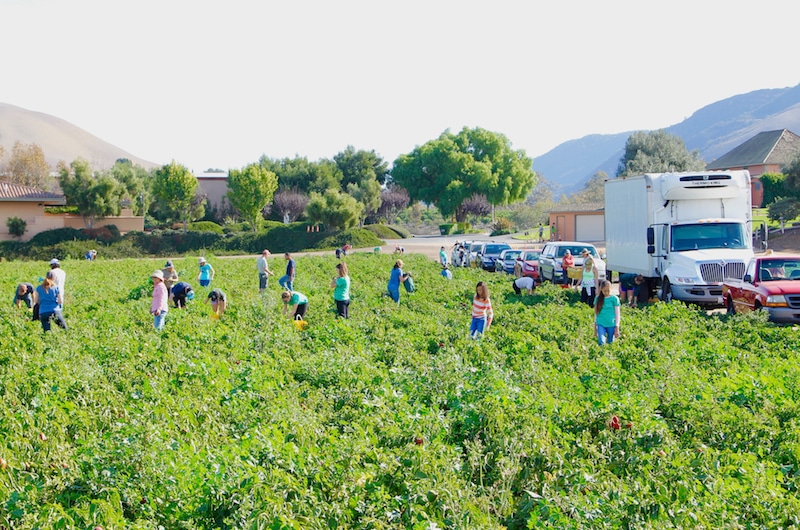 At the same time, we should be doubly wary of any trace of sentimentality in our food politics. Good food is a necessity, not a trend. We know too well how “foodie culture” obscures the ways food actually functions a class marker. When I lived on the East Coast, I would sometimes help prepare dinner at a homeless shelter that seemed to serve nothing but hotdogs. Can we do better than this? (“It’s better than nothing—beggars can’t be choosers” said one of the men to me sardonically, trying to make light of his situation, or unsettle me, or both.) Granted: I do appreciate a good hotdog, especially the Dollar Dogs on Wednesdays at the Oakland Coliseum. “Green-collar baseball,” we A’s fans call it. But a hotdog a day? Food is more than calories; food is dignity, connection, an essence, an energy. At least for those with the education and the means. So why not serve people food we would choose to subsist on ourselves—food that will not in the long run cause harm to those who can least afford it? Men and women cannot live on pasta and potatoes alone, spiritually or gastronomically speaking. And on the fertile Central Coast, no one should have to. Most well-run food banks and shelters recognize the inherent relation between nutritious food and self-worth: it’s difficult to believe you matter when no one else seems to. Glean SLO offers one tangible way to bridge the gap by providing fresh produce to people who deserve it, which is to say, everyone. Cornell West, one of our most trenchant public intellectuals, likes to say that justice is what love looks like in public. By this definition, organizations like Glean SLO might be the real food lovers—those who show love through food, without expectation of returns—all due honor and respect to Novo’s delicious, artful, and locally sourced soups and salads.
At the same time, we should be doubly wary of any trace of sentimentality in our food politics. Good food is a necessity, not a trend. We know too well how “foodie culture” obscures the ways food actually functions a class marker. When I lived on the East Coast, I would sometimes help prepare dinner at a homeless shelter that seemed to serve nothing but hotdogs. Can we do better than this? (“It’s better than nothing—beggars can’t be choosers” said one of the men to me sardonically, trying to make light of his situation, or unsettle me, or both.) Granted: I do appreciate a good hotdog, especially the Dollar Dogs on Wednesdays at the Oakland Coliseum. “Green-collar baseball,” we A’s fans call it. But a hotdog a day? Food is more than calories; food is dignity, connection, an essence, an energy. At least for those with the education and the means. So why not serve people food we would choose to subsist on ourselves—food that will not in the long run cause harm to those who can least afford it? Men and women cannot live on pasta and potatoes alone, spiritually or gastronomically speaking. And on the fertile Central Coast, no one should have to. Most well-run food banks and shelters recognize the inherent relation between nutritious food and self-worth: it’s difficult to believe you matter when no one else seems to. Glean SLO offers one tangible way to bridge the gap by providing fresh produce to people who deserve it, which is to say, everyone. Cornell West, one of our most trenchant public intellectuals, likes to say that justice is what love looks like in public. By this definition, organizations like Glean SLO might be the real food lovers—those who show love through food, without expectation of returns—all due honor and respect to Novo’s delicious, artful, and locally sourced soups and salads. One last confession in this already-too-long blog post: I know next to nothing about agricultural economics, or really economics of any sort. (Robert Graves: “There’s no money in poetry, but then there’s no poetry in money, either.” Thankfully, there’s just enough of both in teaching.) All I know of modern supply-side profit economics is that it’s predicated upon scarcity. Supply and demand. This is the only evidence an ordinary person needs to grasp that economics, while perhaps a useful tool for maximizing certain material outcomes, is not a sane model upon which to build a society. We would do much better cultivating the agrarian principles practiced by the gleaners in our midst: generosity, togetherness, abundance. What would it mean to act out of a paradigm of abundance and love, rather than scarcity and fear? What of equivalent “value” can we receive in exchange for good food, clean water, friends, family, real community, beauty, purpose?
One last confession in this already-too-long blog post: I know next to nothing about agricultural economics, or really economics of any sort. (Robert Graves: “There’s no money in poetry, but then there’s no poetry in money, either.” Thankfully, there’s just enough of both in teaching.) All I know of modern supply-side profit economics is that it’s predicated upon scarcity. Supply and demand. This is the only evidence an ordinary person needs to grasp that economics, while perhaps a useful tool for maximizing certain material outcomes, is not a sane model upon which to build a society. We would do much better cultivating the agrarian principles practiced by the gleaners in our midst: generosity, togetherness, abundance. What would it mean to act out of a paradigm of abundance and love, rather than scarcity and fear? What of equivalent “value” can we receive in exchange for good food, clean water, friends, family, real community, beauty, purpose?
Think of the story of Ruth, gleaning “in tears amongst the alien corn” until she meets her “kinsman-redeemer” Boaz. The point is clear: abundance names our right relation to reality, a relation that, though not always achievable in a strictly material sense, we still have the freedom to assume, and by assuming, possess. I think this is what a good deal of poetry, and perhaps most theology, is trying to tell us. We could do worse. I only know that, for my part, the more suffering I encounter in the world, the more I am inclined to trust beauty’s witness to ever more abundant ways of being. Here’s how Lee’s poem ends:
There are days we live
as if death were nowhere
in the background; from joy
to joy to joy, from wing to wing,
from blossom to blossom to
impossible blossom, to sweet impossible blossom.
 At SLOCA, we study the rise and fall of civilizations. People come and go. They plant, they harvest, they depart. They write. They war. They dream of the impossible. Sometimes they pass on some of what they know, their roots, their culture. We receive all of this, and do what we can to make our small bit of it better. We may, if we choose, try to live in abundance. We may live from blossom to blossom. In the meantime, we glean what we can.
At SLOCA, we study the rise and fall of civilizations. People come and go. They plant, they harvest, they depart. They write. They war. They dream of the impossible. Sometimes they pass on some of what they know, their roots, their culture. We receive all of this, and do what we can to make our small bit of it better. We may, if we choose, try to live in abundance. We may live from blossom to blossom. In the meantime, we glean what we can.




